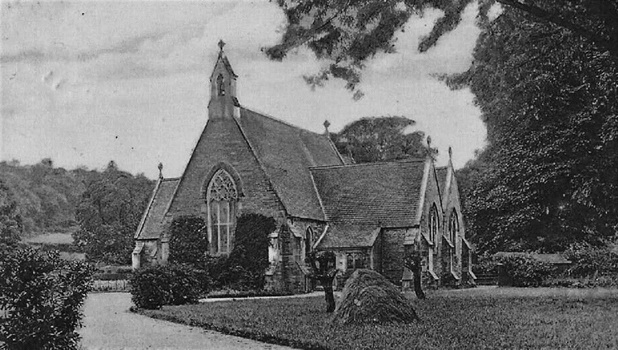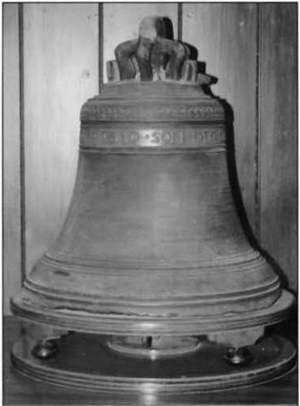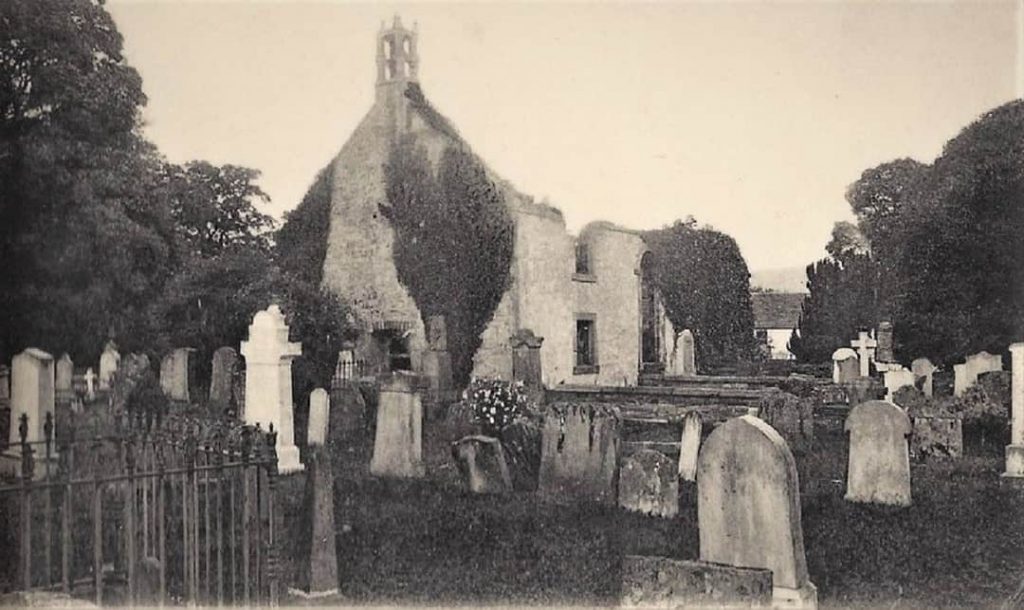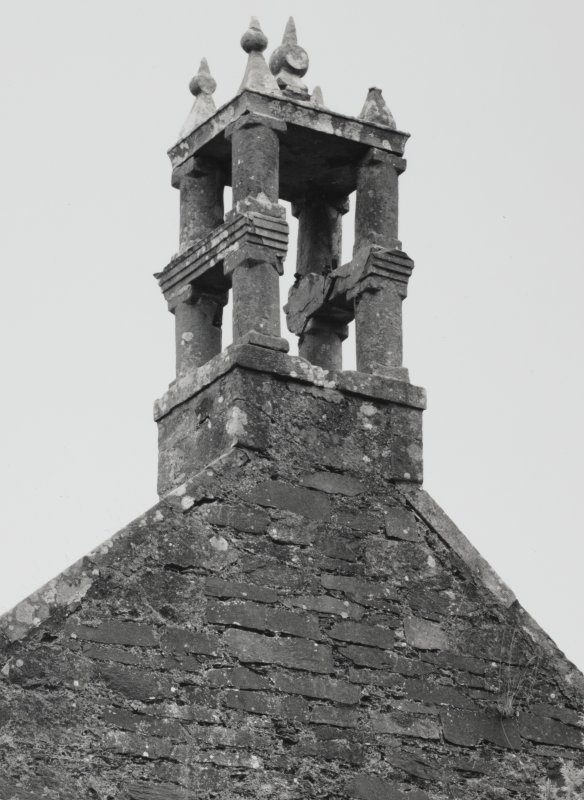In the small Village of Rosneath, Argyll and Bute, Scotland, lies the church dedicated to Saint Modan, one of the early leaders of Celtic Christianity. The current church built in 1853 and dedicated to St. Modan, is one of a succession of several churches built over many centuries in the Clachan of Rosneath (Roseneath), the earliest of which dated back to the Dark Ages and the time of St. Modan.

Today in the north transept of St Modan’s church Rosneath, sits The Burgerhuis Bell. The Rosneath Parish bell was ordered in response to John Knox’s book of 1560, the Buke of Discipline. Therein Knox urged, “that every Church must have a bell to convocat the people together”.

The Bell was cast in 1610 by Ian Burgerhuis (Jan Burgerhuys), the family of whom were renowned Master Founders of the Middelburg foundry, Zeeland, Netherlands. The bell is one of 34 bells supplied to Scottish churches in early 17th century and is one of the earliest Post-Reformation bells in Dunbartonshire. The casting of the bell is very smooth with an attractive decoration and inscription that reads “Ian burgerhuis mefecil 1610.soli dei Gloria”. (Ian Burgerhuis made me in 1610 to the Glory of God alone)
The Rev Meiklejohn who ministered here at Rosneath – 1972-79, produced a scholarly description of the ‘Burgerhuis Bell’. He described Ian Burgerhuis as having established a gun foundry in Middleburgh in 1593, where some years later he went in for bell making, a business which the family firm continued for nearly the whole of the seventeenth century. In 1607 the Burgerhuys foundry cast the bell for the Nieuwe Kerk (New Church) in Delft. The Grote Kerk, (Great Church) in Zwolle which had a fine carillon cast by Ian Burgerhuys. An Englishman, Robert Hargrave, heard it in 1653, and writing enthusiastically stated that “it sounded so musically that till I heare something better I shall esteeme it without equal”. Unfortunately, that superb suite of bells was destroyed by fire some years later.
By the end of the sixteenth century considerable numbers of church bells were being imported from the Netherlands into Scotland, doubtless to comply with the ‘Buke of Discipline’, with the Burgerhuys family having a large share of this trade. Two of the earliest Burgerhuys bells in Scotland are those at Melrose Abbey and the Canongate Church in Edinburgh – 1608. On the death of Ian (Jan) Burgerhuys in 1617, the Middleburgh foundry came into the hands of his son Michael, who between 1617 and 1647 supplied twenty-three bells to Scottish Churches, more than any of his fellow bell makers in a land famous for that craft. Michael died in 1679 and was succeeded by his son Johannes, who provided several more bells for Churches in Scotland, bringing the known total made by the Burgerhuis family for Scottish Kirks up to thirty-four. The seventeenth century saw an increasing production of Scottish made bells based on the Dutch models with several Edinburgh foundries producing fine examples.
In the seventeenth century the old Medieval Parish church was rebuilt, with the ornate Bellcote (belfry) and Burgerhuis Bell being added to the old church in 1610. The church was again rebuilt in 1780 through the efforts of Reverend Drummond, who ministered here at ‘Roʃneath’ between 1766-1819. The Rev Drummond remodelled the old ‘Cruciform’ shaped Church, which by that time was in a “thoroughly bad state of repair”. The restored church was given an oblong shape, retaining the earlier appended gable end and Bellcote. The church was plain and austere, but in keeping with Parish churches of the eighteenth century. This was a distinct improvement over the old church, now having larger windows with ampler and dryer accommodation.


The old Parish church remained in use until 1853, when it was replaced by the current church of St Modan’s, just a few yards further down the ‘Clachan’. At that time the bell was moved from the old Parish Church to the new church, where it continued to ring in the new church Bellcote until 1907. Thereafter the old Burgerhuis Bell was considered too fragile and moved to an honoured position in the Transept of St Modan’s church, it was replaced by the more utilitarian bell in the St Modan’s church Bellcote. Here that simple bell has called the community to prayer, celebration and sadness throughout the momentous times of the twentieth century, for the last one hundred and seventeen years. Who was the maker of that bell, we may ask?
The ruins of the old church, listed by Historic Environment Scotland, is still visible today, in what is now the Rosneath old Parish Churchyard and Cemetery. The Churchyard, although a little overgrown and unkept, is full of atmospheric beauty and cultural significance, as a reminder of the long history of this community.
It is believed that this bell is the same mentioned by Sir Walter Scott in his 19th century book, ‘Heart of Midlothian’, a story based on the true-life story of Helen Walker of Edinburgh. In that story, Jeanie Deans was sent by the Duke of Argyll back to Scotland, and on reaching Rosneath, found that the Duke had installed her boyfriend as Minister of Rosneath. The story describes the old bell as being cracked, “the bell was heard from the old moss-grown tower, and the clapper continued to thump its cracked sides”. However, this is considered as literary licence as the cherished bell remains intact today and is thought to still ring clear.
The Burgerhuis bell had presided over a community that had changed a great deal during its illustrious service. The Bell had rung out over the Gareloch, noting the highpoints of alarms and celebrations for over 300 years. During the Jacobite Rising of 1715 the Church Bell was ordered rung by the then parish minister, Neill Campbell. He gathered “fifty stout parishioners together and marched at their head to join the John, Duke of Argyll on the side of the government”. They met the Duke near Stirling, who with astonishment remarked that the men of Rosneath were more suitable for handling the plough and the oar, than the sword or spear. He commended their patriotism and retained some for service on the boats, supporting the army on shore. Neill Campbell (1678-1761) was a Gaelic speaker due to the parish requiring a Gaelic minister. As late as 1720, there were still 26 families in the area who understood no English. Like many of Rosneath’s sons and clergy, Neill Campbell went on to be the distinguished Principal of Glasgow University in 1728.
